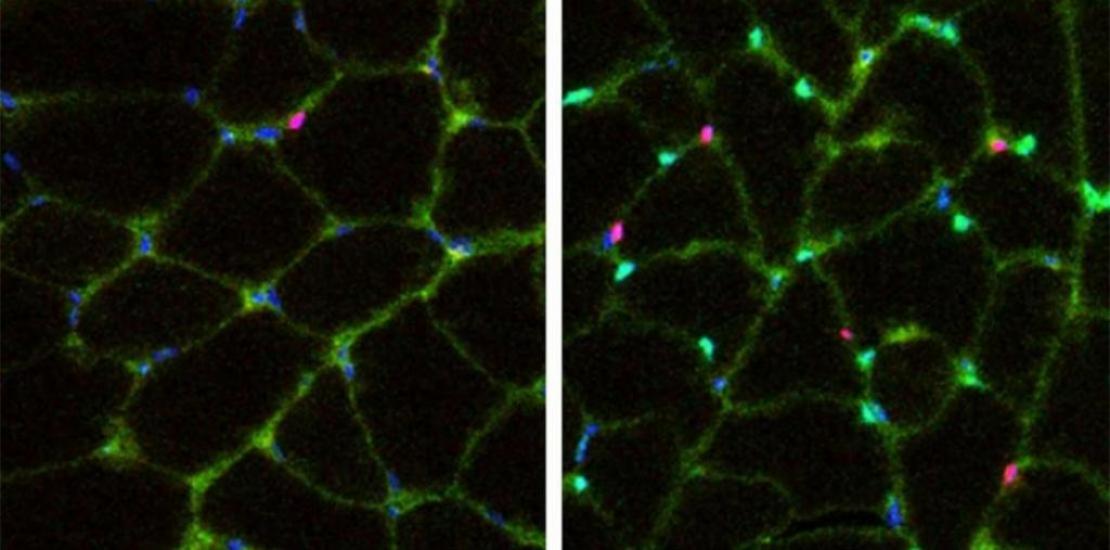Researchers led by Izpisúa halve the healing time of muscle injuries
The results of the study, published today in the Nature Communications journal, represent a major step forward that will benefit athletes and the elderly in particular
The team of researchers led by Juan Carlos Izpisúa, professor of Developmental Biology at UCAM and professor at the Salk Institute in La Jolla (USA), has achieved a new milestone by regenerating injured muscle tissue, halving the recovery time. The work, published in the Nature Communications journal, is promoted and financed by UCAM, the Pedro Guillén Foundation, the Spanish Footballers’ Association (AFE) and the Mapfre Medicine Foundation, in cooperation with the Spanish Olympic Committee (COE), presided over by Alejandro Blanco.
José Luis Mendoza, president of UCAM, indicated that “this research is going to be a historic milestone for medicine and a great asset for humanity. One of the main objectives of our university is research in the field of health, sport and nutrition”. For Alejandro Blanco, president of the COE, “this is an extremely important event for the future of the recovery of muscle injuries for athletes and for all mankind. This is historic research, with Spanish leadership, and great news for science and sport, which must go hand in hand”.
Other prestigious researchers have participated in this work, such as Pedro Guillén, founder of the Cemtro Clinic (FIFA Clinic of Excellence), professor and director of the Chair of Sports Traumatology at UCAM and honorary dean of its Faculty of Medicine.
Shortening the recovery time for muscle injuries in athletes is a historic challenge, but such a reduction would also be of great benefit for the entire population, especially the elderly who, after a long period of immobilisation due to health problems or simply due to the passage of time, suffer from loss of muscle mass. In February 2018, at an event organised by UCAM and COE, Dr Juan Carlos Izpisúa presented the beginning of this project, and explained the increasing difficulty of muscle recovery as we get older. It studies the development and application of advanced therapies to delay muscle ageing or facilitate muscle structural and functional rejuvenation.
José Luis Mendoza, president of UCAM; Alejandro Blanco, president of COE; Dr Juan Carlos Izpisúa and Carmelo Paniagua, president of COE's Sport and Health Commission, at the event organised by UCAM and COE in February 2018 in Madrid, where the beginning of this research was announced.
The first results of this project, which have been now transferred to the scientific community, show that the application of the Yamanaka factors increases the regeneration of muscle cells in mice. This research provides information on the mechanisms involved in muscle regeneration and growth, and it will help both athletes and the elderly to regenerate muscle tissue in a faster and more effective way.
A previous study published by the same research team in 2016 in the Cell journal, also promoted and funded by UCAM, had already shown how the temporary expression of Yamanaka factors (cell reprogramming) in aged mice made them rejuvenate and extend their lifespan by 30%. “Our group showed that these factors can rejuvenate cells and promote tissue regeneration in living animals, but we did not know how it happened”, says first author, Chao Wang.
“These initial results inspired our team and many other researchers to try to rejuvenate and repair various tissues that are affected by ageing”, says Dr Izpisúa, main researcher of the project.
Muscle regeneration is mediated by muscle stem cells, also called satellite cells. “In this work we have used a mouse model that allows us to study how the use of Yamanaka factors causes the activation of muscle stem cells and, as a result, the formation of new fibres is accelerated and muscle regeneration time is halved”, says Rubén Rabadán, postdoctoral researcher.
With this work, researchers have demonstrated, for the first time, how the use of Yamanaka factors accelerate muscle regeneration by reducing the expression of the Wnt4 protein, thus activating satellite cells. In addition, we have also seen an increase in the levels of prostaglandin E2 (PGE2), which is essential for effective muscle stem cells function and muscle regeneration”, says Isabel Guillén, a member of the research team.
Fig. Introduction of Yamanaka factors into myofibers increases the number of myogenic progenitors. Upside: Control. Downside: Treatment
“Muscle injury is the first cause of sick leave in sport. In my long professional life, I have treated hundreds of athletes and other people with muscle injuries without being able to shorten the healing time. We, doctors, are indebted to all of them and we must do research to cure them sooner and better, so today we are happy with the results of our work”, says Dr Pedro Guillén.
The possibility of applying these results to the medical field is really interesting, especially in the field of sports. “The aim of our studies is both to help patients recover mobility lost due to illness or ageing, and to reduce the recovery time for athletes after a muscle injury. We could use this technology to directly reduce Wnt4 levels in skeletal muscle”, explain study co-authors Pedro Guillén, Juan Carlos Izpisúa and Estrella Núñez (vice-chancellor for Research at UCAM).
The use of this technique would also be of great interest for the recovery of muscle mass in patients with reduced mobility for different reasons, for example, due to Covid-19.
Other authors of the study are the following: Paloma Martínez Redondo, Zaijun Ma, Lei Shi, Yuan Xue, Ling Huang, Tomoaki Hishida, Hsin-Kai Liao, Concepción Rodríguez Esteban and Pradeep Reddy from Salk.
ARTICLE IN NATURE COMMUNICATIONS




